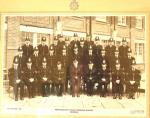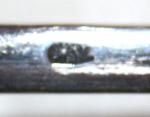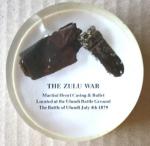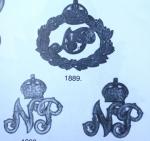-
Posts
13,225 -
Joined
-
Last visited
-
Days Won
22
Content Type
Profiles
Forums
Blogs
Gallery
Events
Store
Everything posted by Mervyn Mitton
-
Rick - outside of my interests - however, attractive medals with the enamel + of course the paperwork. The thought occured to me that the Russian Afghan debacle wasn't that long ago - would make a great post comparing numerical strength with the present allies , casualties and of course objectives gained. Just a thought if you had the interest ? Mervyn
-
Stuart - we had the cadet version for the Geelong Cadet Corps. Much smaller then the full sized version - but, still heavy to us. They had quite a kick when we fired them - this was back in 1949 - don't know when they withdrew them. We had Lee Enfield's when I did my National Service. Good article Peter, I mentioned it as a cross ref. when I recently updated my IKLWA Zulu page..
-
This would appear to be pre-WW2 badge and I find it interesting that it crosses the White Ensign with a Merchant Marine Ensign - and looks to have had a Merchant shipping lines insignia. I am told that this would have probably been worn by a Merchant Navy officer, who also held commissioned rank in the Reserve of the Royal Navy. Any confirmation would be helpful for future reference - also, can we make any guesses to the missing shipping line ?
-
There have been a number of historical group photos shown on this Forum - particularly on the Specials thread. However, it is common practise for the Class to have a photograph taken with Instructors in the Final Week before Passing Out. This is mine - taken in January 1968 - I'm in the third row at end right. Perhaps our many other Police members will be interested in posting theirs - remember, there is an historical content in the Uniforms and the Force - many of which have changed. Look forward to seeing them - and one point, no matter what Rank was achieved we all started at this point !
-
Any idea what make of gun and vehicle ? South Africa - under the old Govt. broke many bans to supply the Middle East armies with our Howitzer and Sp system. Reckoned to be the most effective World wide. They did this to obtain oil.
-
Larry, I had not heard of this new submarine and found the article most interesting. Who says the Brits. aren't still 'up' with the best of them. I thought the bit about tracking ships 3000 miles away quite incredible ! Why don't you post this on the Brit. & Commonwealth Navy section as well - may help to bring that section back to life..... Mervyn
-

WW2 - GERMAN POLICE DRESS BAYONET
Mervyn Mitton replied to Mervyn Mitton's topic in Swords & Edged Weapons
Joe - the overall length is 18.5 inches (48.5cm). Scabbard length is just under 15 inches (37cm) and the length of the blade is just under 13 inches (32cm). Thankyou for your interest in this piece and I look forward to your final conclusions. Mervyn -
There are a number of dealers who specialise in edged weapons - and a member will probably make some recommendations. However, to give yourself a wider choice, I would advise that you start looking at some of the British auction houses who specialise in weaponry. I will list names and you will find that they - and their catalogues - are readily accesible on the web. However, if you have any problems contact me and I will send their addresses. BOSLEY - almost exclusive for all types of militaria. Quality, high - and so can be the prices, but these days, you get what you pay for. Wallis and Wallis - Lewes in Sussex. Very old established militaria auction and they have some lovely pieces coming through. Sothebys ) & Christies ) Both of these have dedicated militaria auctions. Look them up to find dates. These should start you off and there are of course Auction Houses of equal quality in many other Countries.
-

WW2 - GERMAN POLICE DRESS BAYONET
Mervyn Mitton replied to Mervyn Mitton's topic in Swords & Edged Weapons
Joe - I have had a photo taken of the mark on the spine. Not terribly clear and on one shot I thought I could see a '7' - which might be part of a 'K' ? Anyway, this shot seems to show it as a sunburst - see what you think ? -
During the Boer War it became quite a common practise for serving soldiers - officers and other ranks - to give their wives or, sweethearts a brooch with their Regimental Crest. This was carried forward into the 1st. WW and both the Royal Navy and the newly formed Royal Flying Corps did the same - it was a way for the men to be remembered by their loved ones at home. The 2nd. WW saw the same habit of giving brooches and this one is for the RAF. Made of silver , the 'sparkling' stones are actually cut,facetted and polished steel - known as marcasite. Whilst not worn so often these days, it is still a popular collecting field. This example is just under 3 inches across (6cm).
-
One of the questions that frequently comes-up when I am discussing Zulu history and the Battles of 1879 is, what weaponry did the British have ? I think it therefore, right that we should include this topic under the generic of Zulu Iklwas. Peter Suciu has just written an interesting short overall history of the development of the Martini Henry rifle, it is on this sub-forum and I suggest you read it to have greater depth on it's development. I will cover it's history as far as the Zulu War is concerned. The name is derived from Von Martini and A. Henry and it superceded the Enfield of the 1850's as the main rifle of the British Army in 1871. There were many variations over the years and it had a long life . However, we are only concerned with what was in use in 1879. Range wise - it could cover a distance of 14/1500 yards - in effect it was normally fired in the 500 - 700 yards range. (450- 640mtrs). When the opportunity was present the Sgt's used to carry range markers out and hammer them into the ground every 100 yards. Skilled troops could fire at 10 rounds per minute - however, this could cause problems. The barrel would overheat and this could cause the ejector to stick. Many troops carried a piece of damp rawhide to protect their hands. Troops carried 70 round in ready packs - this was heavy as the early ammo. had thin brass cartidge cases. These were later made of waxed cardboard. With a high rate of fire the ammunition was soon exhausted. There were two patterns of bayonet - the type with the downward pointing tip was originally the .577 - and later when .45 was used the end of the bayonet was straight. The blade was 17 inches long (43cm) and triangular in shape. We see mostly the downward tip and at one time they were so common that people lined their garden paths. Nowdays they are quite rare and very sought after. The last Battle of the War was at Ulundi - the King's Kraal. We had 5000 men - including the first battery of Pom Poms used by the British Artillery and also some 260 cavalry of the 17th Lancers. We formed the traditional British Square and the Zulus surrounded and attacked. They nearly broke through in several places - and fought strongly and bravely - however, fire power won and at this time, when the King fled, the Zulu nation ceased to be a fighting power. This .577 cartridge and slug or, bullet, was recovered during the 1940's. The chap who found it placed it on a plastic base and poured liquid plastic over. I think you could buy kits in the 1950's and 60's ? I suppose it has kept them together and preserved them. After 1960 it became an offence to pick-up anything from a Battle site. I can remember visiting Ulundi in the 1950's and the exact layout of the Square could be picked out by the cartridge case trodden into the mud in 1879. Now they are all gone. Officers carried private purchase weapons - the 1845 pattern sword and either the Tranter or, Adams 5 shot percussion cap revolvers. I will cover those in the next post.
-
Dave - welcome to the Forum. You might find this will be overlooked in this position - I would re-post on the Masonic sub-forum, it is towards the lower third of the listings. There are some real experts there, who may be able to help you. An interesting piece, though, - with the names made to look like Regt. Battle Honours.
-
This is the set shown by Brett, above. They were worn from 1902 to 1913. The South African Police were created in that year. There were two styles of Crowns - one is shown on the larger badge - usually worn on the slouch hat. The other - more rounded style is on the collars. illustrations from Colin Owen's book - The Military Badges of South Africa. The numbers are his ref.
-
Marc - welcome to GMIC. Brett has shown above a good set of badges for the early Natal Mounted Police and , then later from 1894, the Natal Police. They continued until 1913 and the formation of the South African Police. From 1894 until 1902 their badge had the Queen Victoria Crown. I will show again, the succession of the badges. The two NMP are helmet plates. The smaller DCP was for the Durban City Police.
-
Mother Kelly ran a common lodging House and for those who were too late - or, couldn't afford her small charge - they spent the night on her front step and in the little green in front. She was immortalised in the Victorian music hall songs. The building still exists - at the corner Of Bethnal Green Road and Cambridge Heath Road , there is still a small lane (Hollybush Gardens) of a few houses and they still face the small green. I think hers is the end one. The famous Arches - again made World famous in the song by Flanagan and Allen - is at the other end of Bethnal Green Road. Before the junction with Shoreditch High Street the long tunnels (nearly 1/4 of a mile long) run from Bethnal Green Road through to Commercial Street. Overhead are all the lines from Bishopsgate. Before the War hundreds of the destitute slept under their shelter. During the War they became very large shelters. Two interesting snippets of our old history , when we were on duty there was always a stream of visitors trying to find them.












